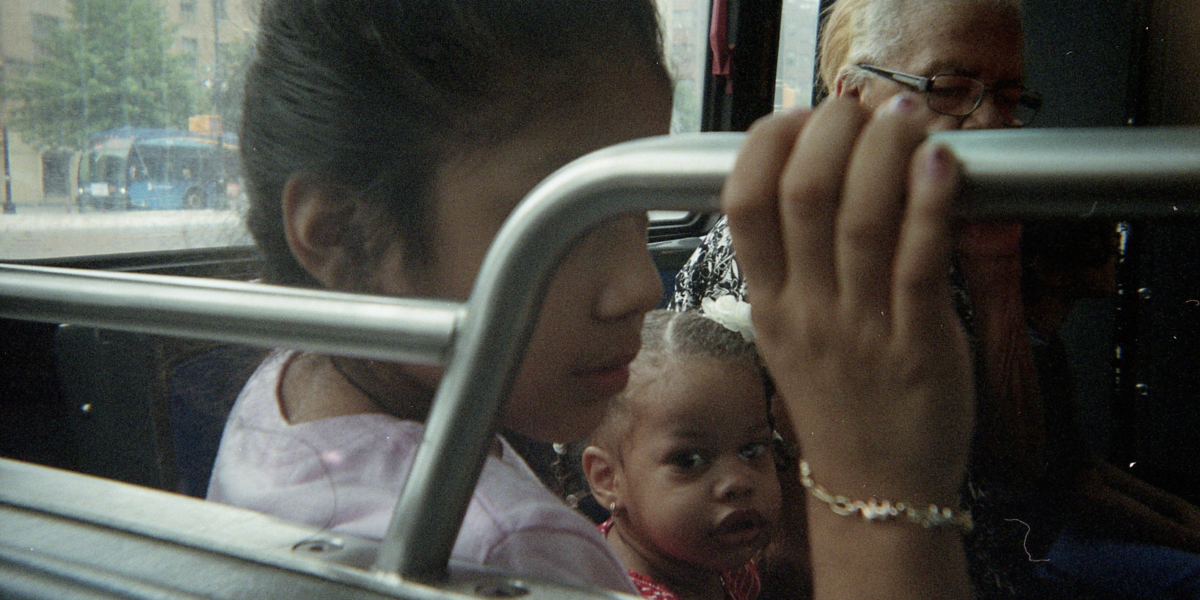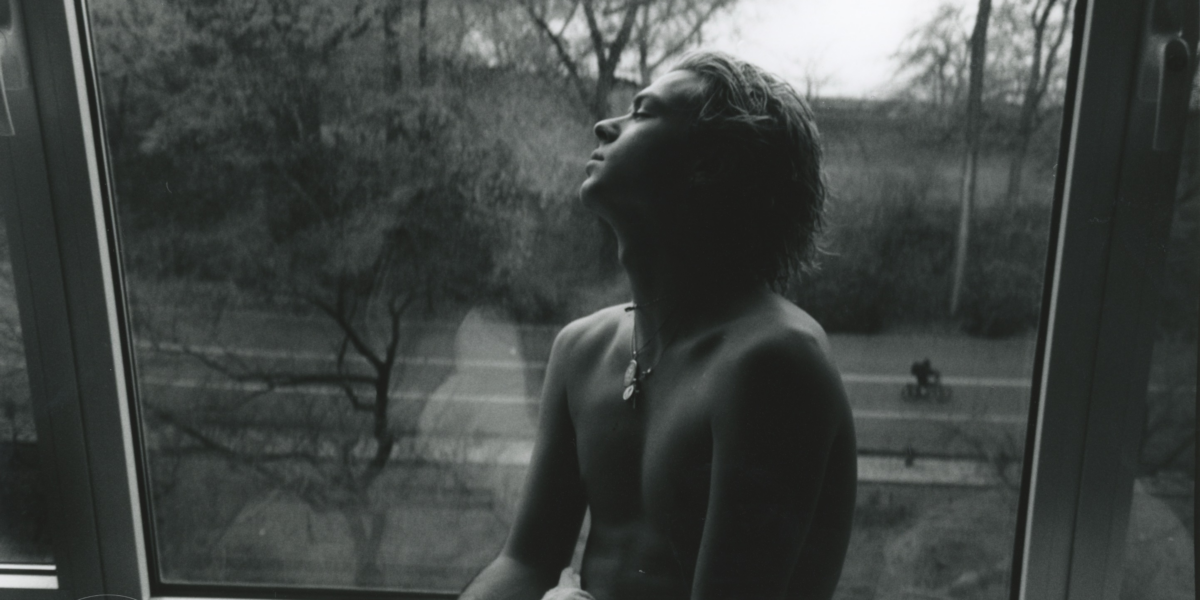Don’t miss out! The Scholastic Awards’ 2024 exhibition: “Por Fin; Paz” will close on Sunday, December 15, 2024. The “Por Fin; Paz” exhibition features Silver and Gold Medalists of the Scholastic Art & Writing Awards’ Photography category from New York City. The Alliance for Young Artists & Writers spoke with two talented teens who have work on display at the Bronx Documentary Center: Cesar Florencio and Samantha Katz!

Cesar Florencio, Por Fin; Paz, Photography.
Cesar Florencio
Tell us about your piece up at the BDC. What inspired you to create it?
My piece “Por fin; Paz,” was created because I wanted less control. I used a Kodak disposable camera to create this piece. I wanted to focus solely on my subjects more than the technical aspects of photography. The disposable let me do that and I focused the frame on my niece Camila. The people sitting by her resembled the stages of life: a toddler, a young child, and an elderly lady. The process and quiet was for me and that is what I feel I captured in this photograph.
How does it feel to have your work exhibited at such a notable venue?
It’s such an honor! The fact that my work is put up and seen by so many people is exciting and this opportunity is amazing. The Scholastic Awards giving me that recognition is such a good push. Receiving an award and getting my work exhibited are proud moments for my journey as a growing artist and person. The Awards are a wonderful reminder that I am on the right path as an artist and I’m so grateful for the organization and the opportunity. I’m especially thankful to everyone who supports them and who’s a part of that community. They truly have made a difference in my artistic journey and help me keep moving forward.
Can you share a bit about your creative process?
I don’t really have a consistent creative process that I stick to. I’m a photographer, so my first step is to always carry my camera with me. Whether I’m going to do laundry or running errands around the city, I try to capture emotion through my photographs. My mood constantly changes and it shows through my art. If I feel down, I see the world through a different lens; I naturally focus and lean towards other people who express that same emotion. I’m very emotional and empathetic and I feel that makes life a little harder but makes art a lot easier.
What message do you hope people take away from your art?
I hope people can resonate with what I create. I hope people can feel some sort of comfort through my art. I’ve always loved artwork that I felt changed me for the better. I want to work to create something tangible to the human spirit. I want to create a community through art, sort of like the Harry Potter or the Studio Ghibli fanbase. Art that can connect people and make others feel less alone is my ultimate end goal as an artist. For now, I’m happy if my art can connect with people in any way. Everyone interprets art differently and I find that so fascinating yet scary.

Samantha Katz, Ricardo, Photography.
Samantha Katz
Tell us about your piece that’s on display at the BDC. What inspired you to create it?
Last year, I submitted a series of photos of my best friend and muse, Ricardo. I met Ricardo while he was doing an exchange program in New York, natively being from Valencia, Spain. He has brought so much joy, laughter, fashion advice, and new culture into my life that I couldn’t be more grateful for. Knowing our time together was limited and he would eventually go back to Europe, we spent as much time together as possible. We scoured Brooklyn vintage stores, went to the Metropolitan opera, had late-night binges of Sex and the City. My mom used to always joke, “Ricardo, do you live here now?” Best of all, we helped each other grow so much. I taught him about my Jewish culture, him falling in love with Matzoh Ball soup. Showed him my perspective of New York—my favorite museums and restaurants and parks. For me, I looked up to Ricardo. His effortless style and sophisticated taste in artistry. The way he could dress up a black turtleneck with vintage jewelry and fur coats. At the end of the day, he is one of the most special people I have ever met, and I feel honored to have captured his beauty.
Using my 35mm Leica, my photo Ricardo captured a repetitive, simple moment in our friendship. An early morning, getting ready to go explore. Ricardo, fresh out of the shower, sat in his favorite spot: the window ledge. In this moment, he wasn’t posing—he was simply himself. So often, people change their character the minute a camera comes out. But never Ricardo. He looked out at the city, once again mesmerized, taking in the same streets and skyline I had grown accustomed to. And of course, Ricardo looked effortlessly ethereal, even in a towel.
How does it feel to have your work exhibited at such a notable venue?
Having my work exhibited in such a notable venue feels surreal and gratifying. After fostering my passion for photography and submitting to the Scholastic Awards year after year, seeing my work recognized and honored is amazing. My favorite part about the exhibit is the opportunity to inspire young artists to continue creating and believing in their own work. At the opening, I had students approach me with lovely words—that I was an example of the artist they wanted to be. I vividly remember my freshman year, looking up to a girl in my photo class who had won multiple Scholastic Awards. She was the embodiment of what I wanted to achieve, and her passion motivated me to pursue my own work with the same intensity.
Can you share a bit about your creative process?
Pertaining my overall creative process, I try to align my photographs with my other interests. I think photography is one of the best mediums for journalism, so I have worked on capturing moments I find to be culturally significant. Taking photos has trained me to initiate one-on-one conversations, to get past my initial impressions and to keep asking questions. I’ve gained an understanding of people by watching the way they carry themselves. I’ve taken hundreds of pictures of people on the streets of New York, racing through their daily lives, and hundreds more of people at protests, capturing their passion and devastation. I’ve taken photos of grandfathers sweating through Barcelona’s increasingly hot summers, of Icelandic villagers mourning the retreat of their historic glaciers. Of hungry models resigned to a lunch of Diet Coke. I’ve noticed that we tend to look away from things that don’t directly impact us—social injustice, distant conflicts, natural disasters. Documenting broadly can be overwhelming and uncomfortable (sometimes for me and my subjects), but I’ve grown as a journalist and photographer, using my skills to amplify subjects’ stories. Photography is evidence of emotion, experience, and action, but it’s also a way of connecting with communities and social issues. Photography brings visibility to people and problems that can be easy to overlook.
What message do you hope people take away from your art?
In regards to Ricardo, the image is more than just a portrait of a friend—it’s a record of a rare connection and special time in my life. It reminds me of those fleeting months we spent together, knowing that they wouldn’t last forever. This photograph immortalizes the beauty of being teenagers in New York City, the lessons we shared, and the quiet magic of those moments when we were simply ourselves together.
I hope people take away the power of storytelling from my art. There is beauty in everything around us, especially in the fleeting and mundane moments. My work encapsulates topics important to me, like climate change and women’s rights, to start conversations and foster advocacy. I hope my art serves as a reminder that every story deserves to be seen, heard, and remembered.
The Bronx Documentary Center
614 Courtlandt Avenue
Bronx, NY 10455
Gallery Hours
Thursday–Friday, 3:00–7:00 pm
Saturday–Sunday, 1:00–5:00 pm

